女性主义英文介绍40页PPT
- 格式:ppt
- 大小:3.99 MB
- 文档页数:40
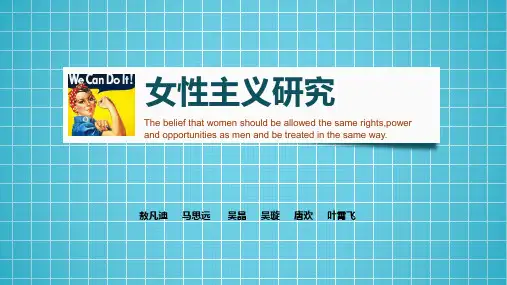

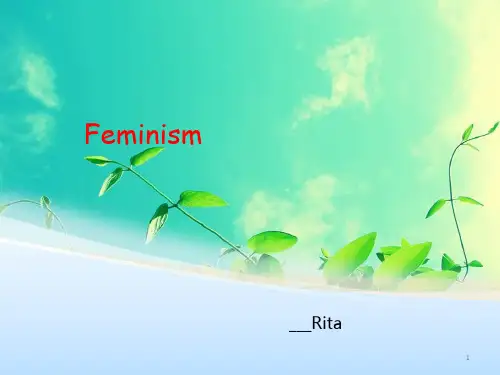

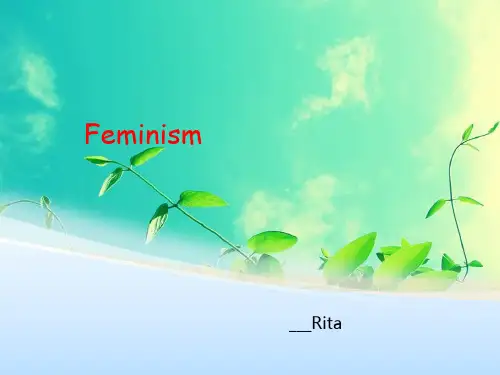
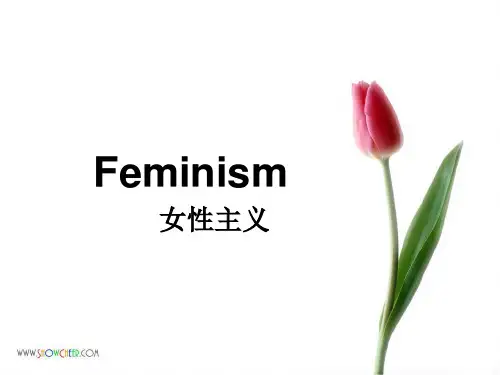
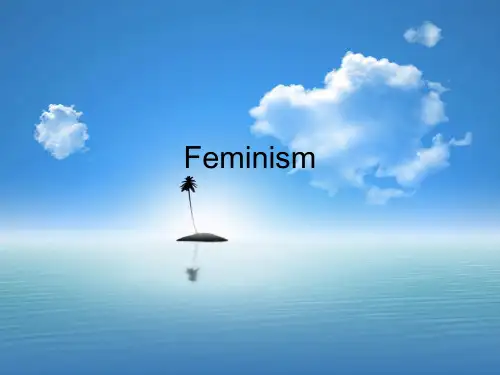
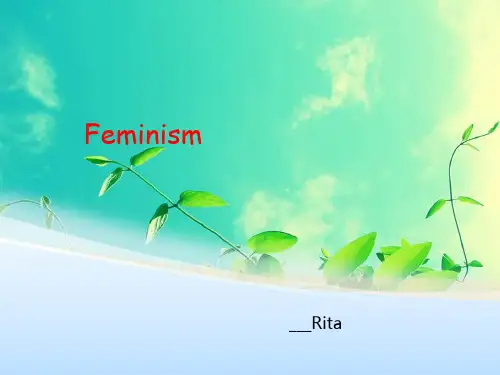

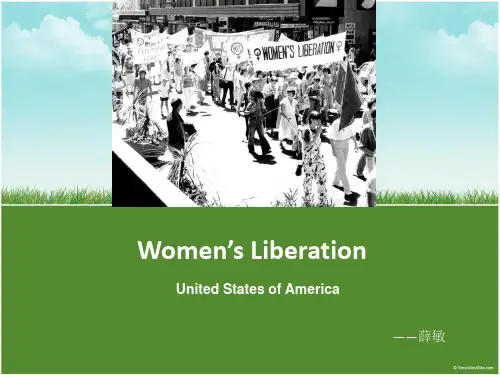
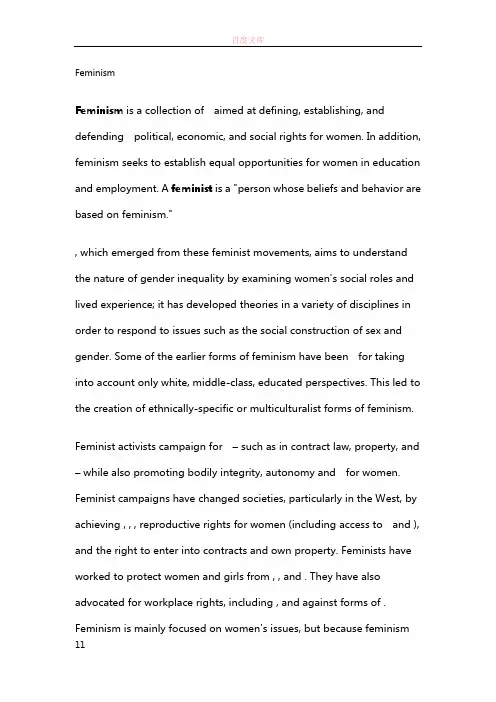
FeminismFeminism is a collection of aimed at defining, establishing, and defending political, economic, and social rights for women. In addition, feminism seeks to establish equal opportunities for women in education and employment. A feminist is a "person whose beliefs and behavior are based on feminism.", which emerged from these feminist movements, aims to understand the nature of gender inequality by examining women's social roles and lived experience; it has developed theories in a variety of disciplines in order to respond to issues such as the social construction of sex and gender. Some of the earlier forms of feminism have been for taking into account only white, middle-class, educated perspectives. This led to the creation of ethnically-specific or multiculturalist forms of feminism. Feminist activists campaign for – such as in contract law, property, and – while also promoting bodily integrity, autonomy and for women. Feminist campaigns have changed societies, particularly in the West, by achieving , , , reproductive rights for women (including access to and ), and the right to enter into contracts and own property. Feminists have worked to protect women and girls from , , and . They have also advocated for workplace rights, including , and against forms of . Feminism is mainly focused on women's issues, but because feminismseeks gender equality, some feminists argue that is a necessary part of feminism, and that men are also harmed by sexism and gender roles. Contents[]•ooo••ooooo•ooooo•oooo•o▪▪•ooo•o•oo••••ooooHistoryFeminist Suffrage Parade in New York City, May 6, 1912.Main article:See also:Depending on historical moment, culture and country, feminists around the world have had different causes and goals. Most western feminist historians assert that all movements that work to obtain should be considered feminist movements, even when they did not (or do not) apply the term to themselves. Other historians assert that the term should be limited to the modern feminist movement and its descendants. Those historians use the label "" to describe earlier movements.The history of the modern western feminist movements is divided into three "waves". Each wave dealt with different aspects of the same feminist issues. The comprised movements of the nineteenth and early twentieth centuries, promoting women's right to vote. The was associated with the ideas and actions of the beginning in the 1960s. The second wave campaigned for legal and social equality for women. The is a continuation of, and a reaction to, the perceived failures of second-wave feminism, beginning in the 1990s.Nineteenth and early twentieth centurieswas a period of activity during the nineteenth century and early twentieth century. In the and , it focused on the promotion of equal contract, marriage, parenting, and property rights for women. By the end of the nineteenth century, activism focused primarily on gaining political power, particularly the right of women's , though some feminists were active in campaigning for women's sexual, , and economic rights as well.along with other suffragettes in 1935. The newspaper headline reads "The Frenchwoman Must V ote."was achieved in Britain's colonies at the close of the 19th century, with the self-governing colonies of and granting women the in 1893 and 1895 respectively. It was followed by Australia permitting women to stand for parliamentary office and granting women the right to vote.In the and the campaigned for the women's vote, and in 1918 the was passed granting the vote to women over the age of 30 who owned houses. In 1928 this was extended to all women over twenty-one. In the U.S., notable leaders of this movement included , , and , who each campaigned for the prior to championing women's right to vote. These women were influenced by the theology of spiritual equality, which asserts that men and women are equal under God. In the United States, first-wave feminism is considered to have ended with the passage of the (1919), granting women the right to vote in all states. The term first wave was coined retroactively to categorize these western movements after the term began to be used to describe a newer feminist movement that focused as much on fighting social and cultural inequalities as political inequalities.During the late and reform movements such as the , Chinese feminists called for women's liberation from traditional roles and gender segregation. Later, the created projects aimed at integrating women intothe workforce, and claimed that the revolution had successfully achieved women's liberation.In 1899, , considered the "father" of Arab feminism, wrote The Liberation of Women, which argued for legal and social reforms for women. founded the in 1923, and became its president and a symbol of the Arab women's rights movement. Arab feminism was closely connected with .The in 1905 triggered the , which aimed to achieve women's equality in education, marriage, careers, and legal rights. However, during the of 1979, many of the rights that women had gained from the women's movement were systematically abolished, such as the .In France, women obtained the only with the of 21 April 1944. The Consultative Assembly of Algiers of 1944 proposed on 24 March 1944 to grant eligibility to women but following an amendment by , they were given full citizenship, including the right to vote. Grenier's proposition was adopted 51 to 16. In May 1947, following the , the sociologist Robert Verdier minimized the "," stating in that women had not voted in a consistent way, dividing themselves, as men, according to social classes. During the period, feminism waned in importance. Wars (both World War I and World War II) had seen the provisional emancipation of some, individual, women, but post-war periods signaled the return to conservative roles.Mid-twentieth centuryFrench philosopher provided a solution and an view on many of the questions of feminism with the publication of Le Deuxième Sexe() in 1949. The book expressed feminists' sense of injustice. is a feminist movement beginning in the early 1960s and continuing to the present; as such, it coexists with . Second wave feminism is largely concerned with issues of equality other than suffrage, such as ending discrimination.Second-wave feminists see women's cultural and political inequalities as inextricably linked and encourage women to understand aspects of their personal lives as deeply politicized and as reflecting power structures. The feminist activist and author coined the slogan "The Personal is Political", which became synonymous with the second wave.Second and third-wave feminism in China has been characterized by are-examination of women's roles during the communist revolution and other reform movements, and new discussions about whether women's equality has actually been fully achieved.In 1956, President of Egypt initiated "", which outlawed discrimination based on gender and granted women's suffrage, but also blocked political activism by feminist leaders. During 's presidency, his wife, , publicly advocated for further women's rights, though Egyptian policy and society began to move away from women's equality with the new movement and growing conservatism. However, some activists proposed a new feminist movement, , which argues for women's equality within an Islamic framework.In Latin America, revolutions brought changes in women's status in countries such as , where aided women's quality of life but fell short of achieving a social and ideological change.Late twentieth and early twenty-first centuriesIn the early 1990s in the USA, began as a response to perceived failures of the second wave and to the backlash against initiatives and movements created by the second wave. Third-wave feminism seeks to challenge or avoid what it deems the second wave's definitions of , which, they argue, over-emphasize the experiences of upper middle-class white women. Third-wave feminists often focus on "micro-politics" and challenge the second wave's paradigm as to what is, or is not, good for women, and tend to use a interpretation of gender and sexuality. Feminist leaders rooted in the second wave, such as , , Chela Sandoval, , , , and many other black feminists, sought to negotiate a space within feminist thought for consideration of race-related subjectivities.Since the 1980s have argued that the feminist movement should address global issues (such as rape, , and ) and culturally specific issues (such as in some parts of Africa and the Middle East and practices that impede women's advancement in developed economies) in order to understand how gender inequality interacts with , , and in a "matrix of domination." Third-wave feminism also contains internal debates between , who believe that there are important differences between the sexes, and those who believe that there are no inherent differences between the sexes and contend that gender roles are due to .The term is used to describe a range of viewpoints reacting to feminism since the 1980s. While not being "anti-feminist", post-feminists believe that women have achieved second wave goals while being critical of third wave feminist goals. The term was first used to describe a backlash against , but it is now a label for a wide range of theories that take critical approaches to previous feminist discourses and includes challenges to the second wave's ideas. Other post-feminists say thatfeminism is no longer relevant to today's society. Amelia Jones has written that the post-feminist texts which emerged in the 1980s and 1990s portrayed second-wave feminism as a monolithic entity.TheoryMain article:See also: andFeminist theory is the extension of feminism into theoretical or philosophical fields. It encompasses work in a variety of disciplines, including , , , , , , and . Feminist theory aims to understand and focuses on gender politics, power relations, and sexuality. While providing a critique of these social and political relations, much of feminist theory also focuses on the promotion of women's rights and interests. Themes explored in feminist theory include , , (especially ), , and .In the field of , describes the development of feminist theory as having three phases. The first she calls "feminist critique", in which the feminist reader examines the ideologies behind literary phenomena. The second Showalter calls "", in which the "woman is producer of textual meaning". The last phase she calls "gender theory", in which the "ideological inscription and the literary effects of the sex/gender system are explored".This was paralled in the 1970s by , who developed the concept of (which translates as female, or feminine writing). argues that writing and philosophy are and along with other French feminists such as emphasize "writing from the body" as a subversive exercise. The work of the feminist psychoanalyst and philosopher, , has influenced feminist theory in general and in particular. However, as the scholar Elizabeth Wright points out, "none of these French feminists align themselves with the feminist movement as it appeared in the world".Movements and ideologiesFor more details on the many feminist movements, see .Many overlapping feminist movements and ideologies have developed over the years.Political movementsSome branches of feminism closely track the political leanings of the larger society, such as liberalism and conservatism, or focus on the environment. seeks individualistic equality of men and women through political and legal reform without altering the structure of society. considers the male-controlled hierarchy as the defining feature of women's oppression and the total uprooting and reconstruction of society as necessary. is conservative relative to the society in which it resides. conceives of people as self-owners and therefore as entitled to freedom from coercive interference. does not support relationships. Lesbian feminism is thus closely related. Other feminists criticize separatist feminism as sexist. see men's control of land as responsible for the oppression of women and destruction of the , but a criticism is that ecofeminism focuses too much on a mystical connection between women and nature.Materialist ideologiesRosemary Hennessy and Chrys Ingraham say that materialist feminisms grew out of western marxist thought and have inspired a number of different (but overlapping) movements, all of which are involved in a critique of and are focussed on 's relationship to women. argues that capitalism is the root cause of women's oppression, and that discrimination against women in domestic life and employment is an effect of capitalist ideologies. distinguishes itself from Marxist feminism by arguing that women's liberation can only be achieved by working to end both the economic and cultural sources of women's oppression. believe that and against the require struggling against , which comes from involuntary hierarchy.Black and postcolonial ideologiesSara Ahmed argues that and feminisms pose a challenge "to some of the organizing premises of Western feminist thought." During much of its , feminist movements and were led predominantly by middle-class white women from Western Europe and North America. However women of other races have proposed alternative feminisms. This trend accelerated in the 1960s with the civil rights movement in the United States and the collapse of European colonialism in Africa, the Caribbean, parts of Latin America, and Southeast Asia. Since that time, women in and and who are of colour or various ethnicities or living in poverty have proposed additionalfeminisms. emerged after early feminist movements were largely white and middle-class. Postcolonial feminists argue that oppression and Western feminism marginalized postcolonial women but did not turn them passive or voiceless. is closely related to postcolonial feminism. These ideas also correspond with ideas in African feminism, motherism, Stiwanism, negofeminism, femalism, , and .Social constructionist ideologiesIn the late twentieth century various feminists began to argue that are , and that it is impossible to generalize women's experiences across cultures and histories. draws on the philosophies of and in order to argue that the concept of gender is created socially and culturally through . also emphasize the social construction of gender and the discursive nature of reality, however as Pamela Abbot et al. note, a postmodern approach to feminism highlights "the existence of multiple truths (rather than simply men and women's standpoints)."Cultural movements(or riot grrl) is an underground feminist movement that started in the 1990s and is often associated with . It was grounded in the of . Riot grrls took an stance of and . Riot grrrl's emphasis on universal female identity and separatism often appears more closely allied with second-wave feminism than with the third wave. The movement encouraged and made "adolescent girls’ standpoints central," allowing them to express themselves fully. is a cultural feminist movement that attempts to respond to the backlash of second-wave radical feminism of the 1960s and 1970s by reclaiming symbols of "feminine" identity such as make-up, suggestive clothing and having a sexual allure as valid and empowering personal choices.Societal impactMain article:The feminist movement has effected change in Western society, including ; greater access to education; more nearly equitable pay with men; the right to initiate divorce proceedings; the right of women to make individual decisions regarding pregnancy (including access to and ); and the right to own property.Civil rightsParticipation in the Convention on the Elimination of All Forms of Discrimination Against Women.Signed and ratifiedAcceded or succeededUnrecognized state, abiding by treaty Only signed Non-signatoryFrom the 1960s on, the campaign for was met with mixed results in the U.S. and the U.K. Other countries of the agreed to ensure that discriminatory laws would be phased out across the European Community.Some feminist campaigning also helped reform attitudes to . The view that young girls cause men to have sexual intercourse with them was replaced by that of men's responsibility for their own conduct, the men being adults.In the U.S., the () began in 1966 to seek women's equality, including through the (), which did not pass, although . in the U.S. centered on the court decision in enunciating a woman's right to choose whether to carry a pregnancy to term. Western women gained more reliable , allowing family planning and careers. The movement started in the 1910s in the U.S. under and elsewhere under . In the final three decades of the 20th century, Western women knew a new freedom through , which enabled women to plan their adult lives, often making way for both career and family.The within was affected by the increased entry of women into workplaces in the 20th century. Sociologist found that, in two-career couples, men and women, on average, spend about equal amounts of time working, but women still spend more time on housework, although responded by arguing that women may prevent equal participation by men in housework and parenting.In international law, the (CEDAW) is an international convention adopted by the and described as an international for women. It came into force in those nations ratifying it.LanguageFor more details on this topic, see .Gender-neutral language is a description of which are aimed at minimizing assumptions regarding the biological of human . The advocacy of gender-neutral language reflects, at least, two different agendas: one aims to clarify the inclusion of both sexes or genders (gender-inclusive language); the other proposes that gender, as a category, is rarely worth marking in language (gender-neutral language). Gender-neutral language is sometimes described as non-sexist language by advocates and politically-correct language by opponents.TheologySee also: andCmdr. Adrienne Simmons speaking at the 2008 ceremony for the first and only women's mosque in Khost City, a symbol of progress for growing women's rights in the Pashtun belt.Feminist theology is a movement that reconsiders the traditions, practices, scriptures, and theologies of religions from a feminist perspective. Some of the goals of feminist theology include increasing the role of women among the clergy and religious authorities, reinterpreting male-dominated imagery and language about God, determining women's place in relation to career and motherhood, and studying images of women in the religion's sacred texts. The Christian bible refers to women in authority in Genesis 3:16 and 1 Tim 2:11-13.is a branch of feminist theology which seeks to interpret and understand in light of the equality of women and men, and that this interpretation is necessary for a complete understanding of Christianity. While there is no standard set of beliefs among Christian feminists, most agree that God does not discriminate on the basis of sex, and are involved in issues such as the , male dominance and the balance of parenting in Christian marriage, claims of moral deficiency and inferiority of women compared to men, and the overall treatment of women in the church.advocate , , and social justice grounded within an Islamic framework. Advocates seek to highlight the deeply rooted teachings of equality in the and encourage a questioning of the patriarchal interpretation of Islamic teaching through the Quran, (sayings of ), and (law) towards the creation of a more equal and just society. Although rooted in Islam, the movement's pioneers have also utilized secular and Western feminist discourses and recognize the role of Islamic feminism as part of an integrated global feminist movement.is a movement that seeks to improve the religious, legal, and social status of women within and to open up new opportunities for religious experience and leadership for Jewish women. The main issues for early Jewish feminists in these movements were the exclusion from the all-male prayer group or , the exemption from positive time-bound , and women's inability to function as witnesses and to initiate .Secular or have engaged in feminist criticism of religion, arguing that many religions have oppressive rules towards women and themes and elements in religious texts.PatriarchyMain article:Patriarchy is a social system in which the role of the male as the primary authority figure is central to social organization, and where fathers hold authority over women, children, and property. It implies the institutions of male rule and privilege, and is dependent on female subordination. Most forms of feminism characterize patriarchy as an unjust social system that is to women. As the feminist and political theorist writes: "The patriarchal construction of the difference between masculinity and femininity is the political difference between freedom and subjection." In the concept of patriarchy often includes all the social mechanisms that reproduce and exert male dominance over women. Feminist theory typically characterizes patriarchy as a social construction, which can be overcome by revealing and critically analyzing its manifestations. Some have proposed that because patriarchy is too deeply rooted in society, is the only viable solution. Other feminists have criticized these radical feminist views as being anti-men, though some radical feminists reject this portrayal of their views. Societal tension caused by second-wave feminism gave rise to backlash in the form of anti-feminist men's movements, such as , though today some see masculism as a complementary movement that does not oppose feminism.Men and masculinityMain article:Feminist theory has explored the social construction of masculinity and its implications for the goal of gender equality. The social construct of masculinity is seen by feminism as problematic because it associates males with aggression and competition, and reinforces and unequal genderrelations. The patriarchal concept of masculinity is also seen as harmful to men by narrowing their life choices, limiting their sexuality, and blocking full emotional connections with women and other men. Some feminists are engaged with men's issues activism, such as bringing attention to male rape and spousal battery and addressing negative social expectations for men.Male participation in feminism is encouraged by feminists and is seen as an important strategy for achieving full societal commitment to gender equality. Many male feminists and pro-feminists are active in both women's rights activism, feminist theory, and masculinity studies. However, some argue that while male engagement with feminism is necessary, it is problematic due to the ingrained social influences of patriarchy in gender relations. The consensus today in feminist and masculinity theories is that both genders can and should cooperate to achieve the larger goals of feminism.CultureMain article:According to the , feminist art can "be defined as art by women artists made consciously in the light of developments in feminist art theory since about 1970."ArchitectureGender-based inquiries into and conceptualization of architecture have also come about, leading to . Piyush Mathur coined the term "archigenderic". Claiming that "architectural planning has an inextricable link with the defining and regulation of gender roles, responsibilities, rights, and limitations", Mathur came up with that term "to explore...the meaning of 'architecture' in terms of gender" and "to explore the meaning of 'gender' in terms of architecture".Literature, award winning feminist science fiction author.Further information: andThe feminist movement produced both feminist fiction and non-fiction, and created new interest in women's writing. It also prompted a general reevaluation of women's and academic contributions in response to the belief that women's lives and contributions have been underrepresented as areas of scholarly interest. Much of the early period of feminist literary scholarship was given over to the rediscovery and reclamation of texts written by women. Studies like Dale Spender's Mothers of the Novel (1986) and Jane Spencer's The Rise of the Woman Novelist (1986) were ground-breaking in their insistence that women have always been writing. Commensurate with this growth in scholarly interest, various presses began the task of reissuing long-out-of-print texts. Virago Press began to publish its large list of 19th and early-20th-century novels in 1975 and became one of the first commercial presses to join in the project of reclamation. In the 1980s Pandora Press, responsible for publishing Spender's study, issued a companion line of 18th-century novels by written by women. More recently, Broadview Press continues to issue 18th- and 19th-century novels, many hitherto out of print, and the University of Kentucky has a series of republications of early women's novels.The widespread interest in women's writing is related to a general reassessment and expansion of the . Interest in , , writing by people of colour, working people's writing, and the cultural productions of other historically marginalized groups has resulted in a whole scale expansion of what is considered "literature," and genres hitherto not regarded as "literary," such as children's writing, journals, letters, travel writing, and many others are now the subjects of scholarly interest. Most have undergone a similar analysis, so that one now sees work on the "female gothic" or .According to Elyce Rae Helford "Science fiction and fantasy serve as important vehicles for feminist thought, particularly as bridges between theory and practice." Feminist science fiction is sometimes taught at the university level to explore the role of in understanding gender. Notable texts of this kind are 's (1969), ' (1970), 's (1979) and 's (1985).MusicMain article:Women's music (or womyn's music or wimmin's music) is the music by women, for women, and about women. The genre emerged as a musical expression of the movement as well as the , , and . The movement was started by lesbians such as , , and , African-American women activists such as and her group , and peace activist . Women's music also refers to the wider industry of women's music that goes beyond the performing artists to include , , , , cover artists, , , and festival organizers who are also women.Feminism became a principal concern of musicologists in the 1980s. Prior to this, in the 1970s, musicologists were beginning to discover women composers and performers, and had begun to review concepts of canon, genius, genre and periodization from a feminist perspective. In other words, the question of how women musicians fit into traditional music history was now being asked.Through the 1980s and 1990s, this trend continued as musicologists like , and Ruth Solie began to consider the cultural reasons for the marginalizing of women from the received body of work. Concepts such as music as gendered discourse; professionalism; reception of women's music; examination of the sites of music production; relative wealth and education of women; popular music studies in relation to women's identity; patriarchal ideas in music analysis; and notions of gender and difference are among the themes examined during this time.Visual artsMain article:The feminist art movement refers to the efforts and accomplishments of feminists internationally to make art that reflects women's lives and experiences, as well as to change the foundation for the production and reception of contemporary art. It also sought to bring more visibility to women within and art practice. Corresponding with general。